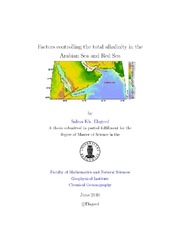| dc.description.abstract | Based on data obtained during the Geochemical Ocean Section Study (GEOSECS) 1977, Mer Rouge (MEROU) 1982, and US Joint Global Ocean Flux (JGOFS) 1995 studies we have analyzed the processes controlling the total alkalinity (TA) of the whole water column in the Arabian Sea and the Red Sea. The main processes important for the TA variability in area of study are salinity variations, soft tissue production, calcium carbonate formation and dissolution, and sedimentation. For the subsurface waters different processes dominate in the different basins. Regarding spatial variations in surface TA, maximum values occur in the Red Sea and minimum in the upwelling region along the Omani coast in the Arabian Sea. These variations are mainly associated with physical processes that control salinity. Alkalinity variations were decomposed to contributions arising from salinity variations (\Delta TA^s), organic matter production/remineralisation (\Delta TA^{org}), and production/dissolution of calcium carbonate (\Delta TA^{CaCO_3}). Positive \Delta values resulted for the processes that increase TA whereas negative \Delta values resulted for the processes that decrease TA. In the upper 200 m of the water column, (\Delta TA^s) was found to be 70 \mu mol kg^{-1} and 121 \mu mol kg^{-1} for the Arabian Sea and the Red Sea, respectively. Below the 200 m depth the \Delta TA^s was 45 \mu mol kg^{-1} and 6 \mu mol kg^{-1} for the Arabian Sea and the Red Sea respectively. \Delta TA^{org} was maximum in surface (24 \mu mol kg^{-1}) for both Seas. For depths below 200 m, \Delta TA^{org} was between -10 and 0 \mu mol kg^{-1} in the Arabian Sea, and between 0 and 10 \mu mol kg^{-1} in the Red Sea. Values for \Delta TA^{CaCO_3} were around 0 \mu mol kg^{-1} in the surface in both regions, but \Delta TA^{CaCO_3} increased nearly linearly with depth in the Arabian Sea until it reached and stabilized to values around 150 \mu mol kg^{-1} at about 3000 m. The increase was due to dissolution of calcium carbonate (CaCO_3) as the Arabian Sea was found to be undersaturated with respect to aragonite and calcite around 400 and 3000 m, respectively. Conversely, the level of undersaturation was never reached in the Red Sea. Thus,sedimentation of CaCO_3 out of the water column was possible in the Red Sea. The fact that \Delta TA^{CaCO_3} decreased and stabilized to a value of -40 \mu mol kg^{-1} at about 500 m depth in the Red Sea suggested that CaCO_3 formation and sedimentation removed TA from the water column. | en_US |
